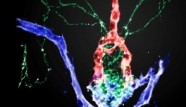Weizmann Institute: Surprising Neuro-Hypophysis Discovery

In a study published recently in Developmental Cell, a team of scientists led by Dr. Gil Levkowitz of the Weizmann Institute has revealed the exact structure of one crucial brain area in which biochemical commands are passed from the brain cells to the bloodstream and from there to the body. In the process, they discovered a surprising new role for the “hormone of love,” showing that it helps to direct the development of this brain structure.
The area in question, the neuro-hypophysis, is an interface between nerve fibers and blood vessels located at the base of the brain. Here, some of the major brain-body interactions take place: Hormones released from nerves into the blood vessels regulate a series of vital body processes, including the balance of fluids and uterine contractions in childbirth.
Although the neurohypophysis has been studied for more than a century, the scientists in the Weizmann Institute-led study developed new genetic tools that enabled them to examine the exact three-dimensional arrangement of this brain structure and clarify the cellular and molecular processes leading to its formation. Since the human neurohypophysis is exceedingly complex, the scientists performed the research on live embryos of zebrafish. These fully transparent embryos offer a unique model for studying the vertebrate brain, lending themselves to genetic manipulation with relative ease and enabling researchers to observe the actual formation of a neurohypophysis under a microscope.
The study revealed a surprising new function for the hormonal messenger oxytocin, dubbed the “hormone of love” because, in addition to controlling appetite and such female reproductive behaviors as breastfeeding, it is also involved in mother-child and mate bonding. The scientists showed that oxytocin, one of the two major hormones secreted in the adult neurohypophysis, is involved in the development of this brain area already in the embryo. At this stage, the oxytocin governs the formation of new blood vessels. “The messenger helps to build the road for transmitting its own future messages,” says Levkowitz. Developmental Cell highlighted the study’s findings in a preview headlined, “The Hormone of Love Attracts a Partner for Life.”
These findings provide an important advance in basic research because they shed light on fundamental brain processes, but in the future they might also be relevant to the treatment of disease. Since the neurohypophysis is one of only a few portions of the brain able to regenerate after injury, an understanding of how it is formed may one day help achieve such regeneration in other parts of the central nervous system.
The research was conducted in Levkowitz’s lab in the Molecular Cell Biology Department by Ph.D. student Amos Gutnick together with Dr. Janna Blechman. The Weizmann scientists worked in collaboration with Dr. Jan Kaslin of Monash University, Australia; Drs. Lukas Herwig, Heinz-Georg Belting and Markus Affolter of the University of Basel, Switzerland; and Dr. Joshua L. Bonkowsky of the University of Utah, United States.


sexy chicks young sex parties…
sexy chicks young sex parties one handsome hugecocked guy is banging two cute…